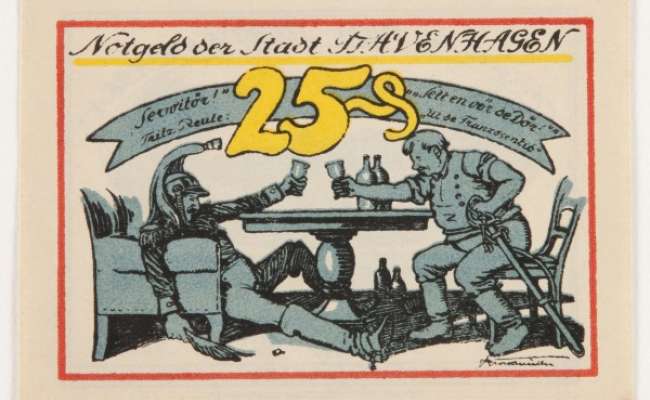1 Mark Lauenburg an der Elbe notgeld
Date
1921
Code
CH/5/4/2/5/64
Level
Item
More details
This notgeld is from Lauenburg an der Elbe and has the value of 1 Mark. It shows a joker performing some tricks in his colourful dress. A group of children is watching him. The inscription in German reads: 'dieses bunte narrenklied stammt aus langst entschwunder zeit. Am Hof des Herzogs Julius Franz trugs der narr in pracht u. glanz' and translates 'This colorful fool's song comes from a long forgotten time. At the court of Duke Julius Franz the fool tricks in glory and splendour' On the other side the joker seems to be leading the children. The inscription in German reads: 'alljährlich in de wintertied/ Komt de schippers von wied und sied /Un fiert hier in ein Sundagsrock/ De Schipperhög mit eiergrog./ Hans Wurst de geiht von hus to hus / Un bringt de schippers een Gruss/ De Gorn in groten schwarm / Makt vor jedes hus den Larm/ Wenn Hanswurst smitt in de Grappeln/ De Fruns er upgehegten Appeln' and translates 'Every year at Wintertide/ the boatmen come [from far and wide?]/ One is here in a Sunday skirt/ the Schipperhog with eggnog/ Hans Wurst goes from house to house/ And brings the boatmen a greeting/ A great swarm of kids/ Makes noise at each house/ When Hans Wurst throws them to the rabble/ The women cherish the apples'. Schipperhöge is a traditional festival that still occurs in January, with two days of parades led by the 'funny person', also known as Hans Wurst. Surrounded by a group of clowns and children, he goes door to door offering New Year's greetings and throwing sweets. This is one of sixty notgeld or 'emergency money' banknotes in the reference collection of packaging material which belonged to the designer Charles Hasler. Notgeld were produced by German towns, villages and municipalities from the end of the First World War until the mid 1920s, when the state bank (the Reichsbank), struggled with wartime metal shortages and post- war hyperinflation. The highly decorative notes soon became collectors items - and still remain to this day. They are double-sided and printed with their monetary value, information about the village, town or province of issue and some colourful illustration.






Comments